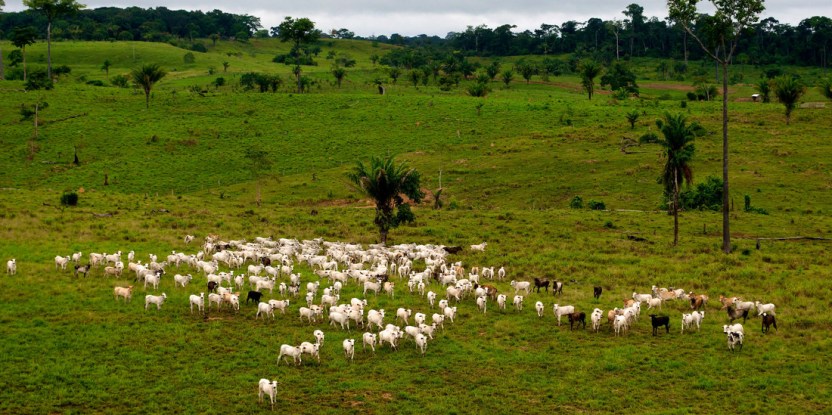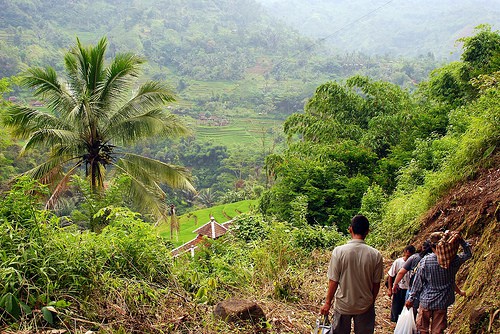
BOGOR, Indonesia — The conversion of pasture to agricultural land has released more carbon from the soil in several South American grasslands in the past 40 years than the conversion of forests to grassland during the three centuries before, according to a new report.
Not only does lost soil carbon cause land degradation and undermine biodiversity, the carbon emissions also contribute to climate change.
With 2015 named the UN International Year of Soils, the book in which the report is published, Soil Carbon: Science, Management and Policy for Multiple Benefits, is well timed.
“We haven’t paid much attention to returning to soils what we take out,” said Christopher Martius, a principal scientist with the Center for International Forestry Research (CIFOR). “It’s much easier to maintain carbon in the soil than to build it up again. There are technologies and approaches to help, but they require a change of mindset, investments and the right policy conditions.”
Previously, Martius worked with Brazilian and Argentinean colleagues through the Inter-American Institute for Global Change Research (IAI) in São José dos Campos, Brazil, to examine the impact of land-use change on carbon stocks in three distinct biomes of central-southern South America: the savannah-like Cerrado in Brazil, the Pampas grasslands in Argentina, and the “Atlantic forests” of the eastern coastal regions. Their work, “Impacts of Land-use Change on Carbon Stocks and Dynamics in Central-southern South American Biomes,” forms one of the book’s 31 chapters.
QUARTET OF CULPRITS
The authors report that four agricultural sectors have done the most damage to soil: commodities such as soybeans; wood such as eucalyptus and pine; cattle; and biofuels made from sugarcane.
In the past 30 years, they note, the area for soybean crops in the Argentinean Pampas has nearly quadrupled, and has expanded by nearly 10 times in the Brazilian Cerrado. The area under sugarcane crops in Brazil has almost doubled in the past 20 years.
Losing carbon from soils where it has been building up over centuries, even millennia, is quite easy to do
Generally, all conversions from natural vegetation to agricultural land systems lead to significant loss of soil carbon stocks. In the Pampa region of the La Plata River basin, the authors note, conversion to croplands has decreased carbon stocks by more than 29 million metric tons per year over the past 25 years.
“If you constantly work the earth, then you expose soil carbon to degradation,” Martius said. “That’s why one of our recommendations is to adopt conservation, or no-tillage, agriculture. With this approach, farmers reduce the number of times they plow and try to keep as many plant residues as possible on the land.”
DON’T BAN BURNING
While conservation agriculture is often touted as a holistic and environmentally friendly approach, it can also make good economic sense. As the researchers point out, many large-scale commercial producers in Brazil have adopted no-tillage approaches because less plowing means less fuel, less machinery and less labor.
“These companies found out they can grow the crops by making small holes in existing vegetation, and planting the seeds in these small holes,” Martius said. “It keeps the land more or less intact, and they still get a good harvest. But they also reduce the loss of carbon because they are not turning the soil as often.”
But preserving soil carbon is often complex, involving many social, environmental and economic trade-offs. Sugarcane producers, for example, burn leaves off before the harvest. This helps reduce the backbreaking labor of their harvesters, but also degrades the soil.
“You can’t ban burning immediately because it helps the laborers,” Martius said. “A ban can only work if they also introduce labor-saving machines. But then you’ve got the problem of half a million people whose jobs may be threatened by new technology. There is no easy solution.”
The researchers recommend a variety of strategies to reduce soil carbon loss in agriculture. These include moving from planting single crops to multiple crops, rotating with legume cover species to enrich the soil with nitrogen that interacts with carbon, or integrating crops with livestock and trees. Such techniques have been shown to boost soil carbon levels by up to nearly two metric tons per hectare each year. Apart from preserving the resilience of the soil, these techniques can also help South American farmers mitigate the negative impacts of climate change.
“Losing carbon from soils where it has been building up over centuries, even millennia, is quite easy to do,” Martius said. “Building it up again is complicated and takes a long time. We can’t get it back as quickly as we destroy it.”
For more information about the issues in this article, please contact Christopher Martius at c.martius@cgiar.org.
CIFOR’s research on forests and agriculture forms part of the CGIAR Research Program on Forests, Trees and Agroforestry.
We want you to share Forests News content, which is licensed under Creative Commons Attribution-NonCommercial-ShareAlike 4.0 International (CC BY-NC-SA 4.0). This means you are free to redistribute our material for non-commercial purposes. All we ask is that you give Forests News appropriate credit and link to the original Forests News content, indicate if changes were made, and distribute your contributions under the same Creative Commons license. You must notify Forests News if you repost, reprint or reuse our materials by contacting forestsnews@cifor-icraf.org.
